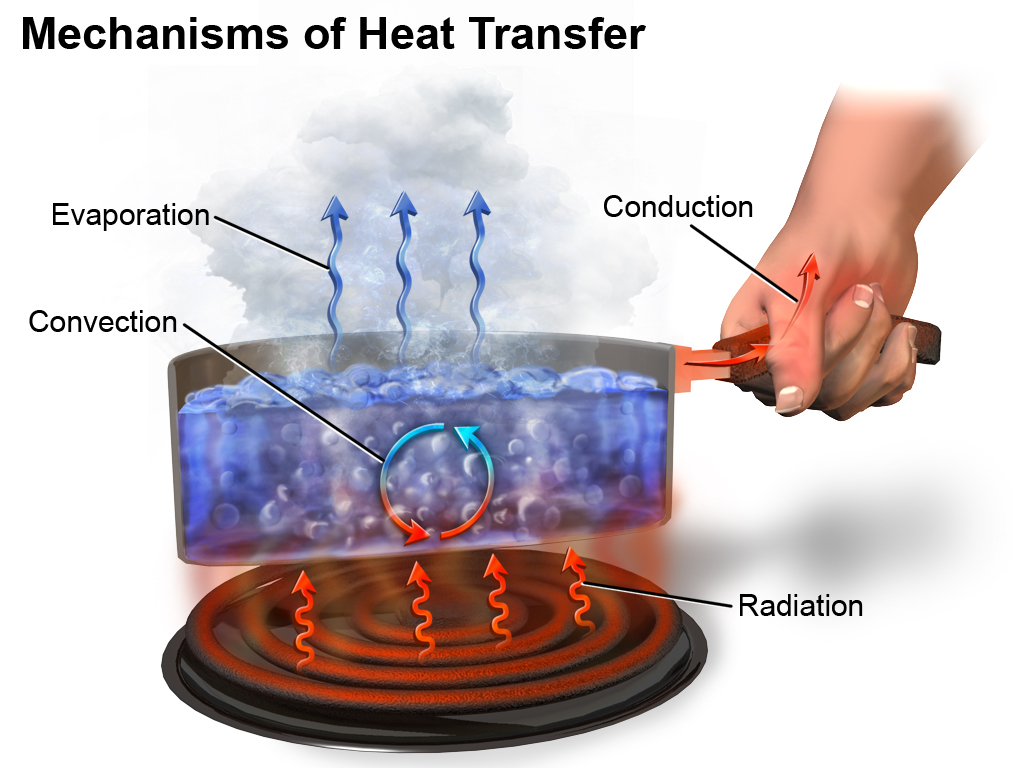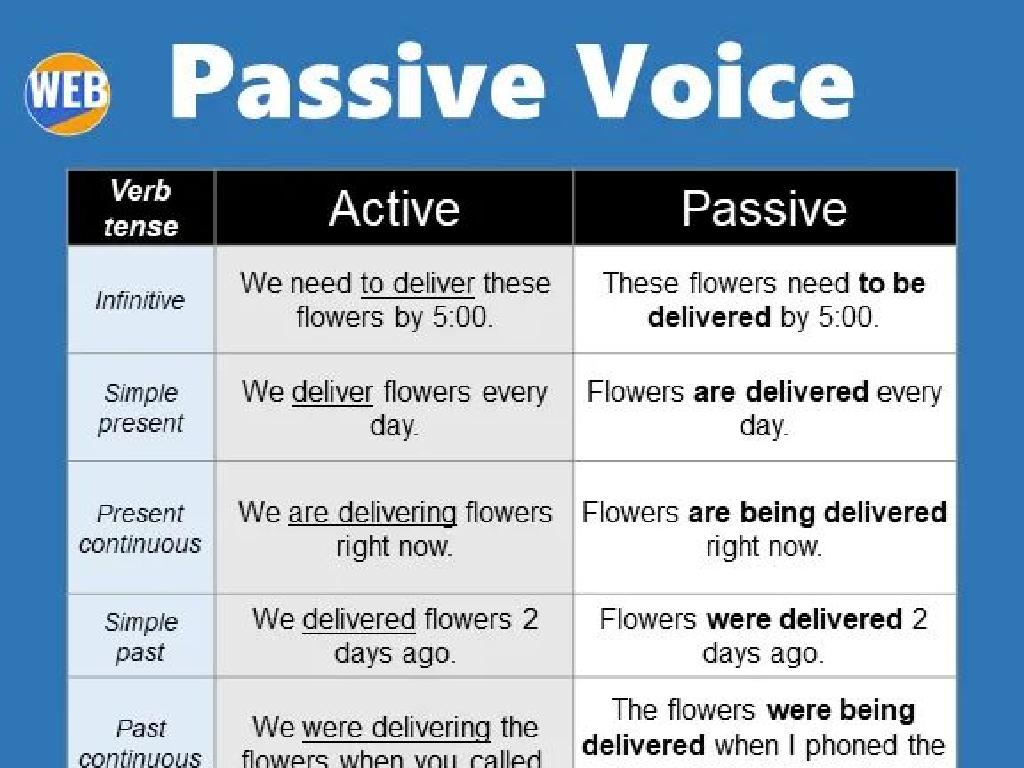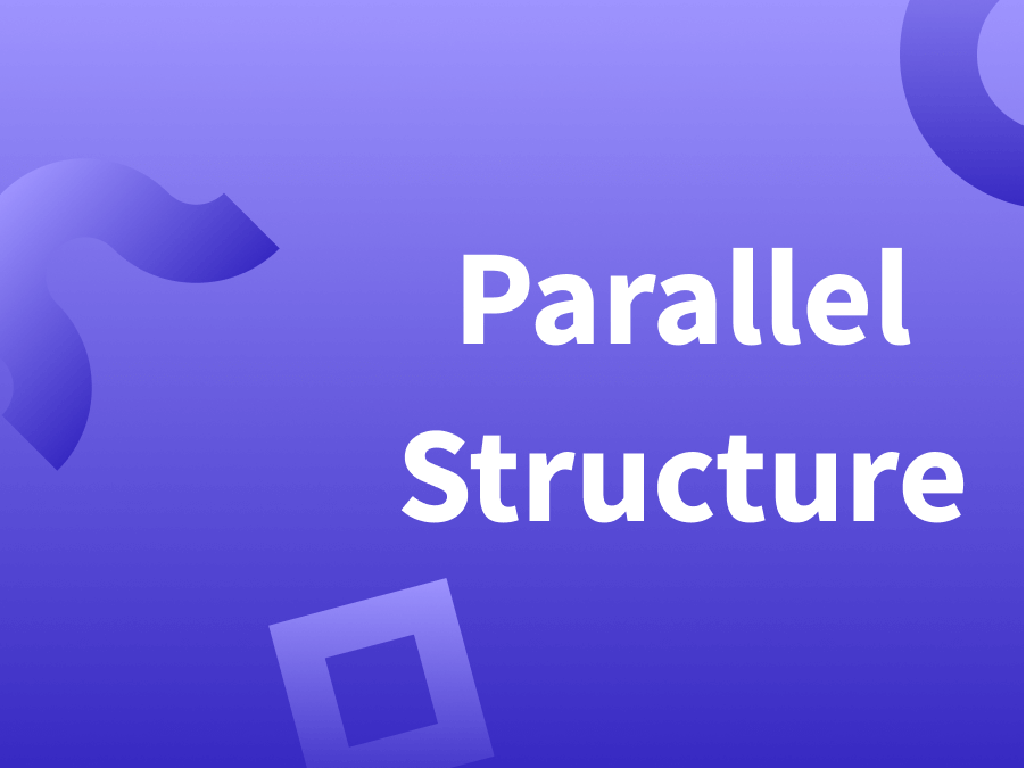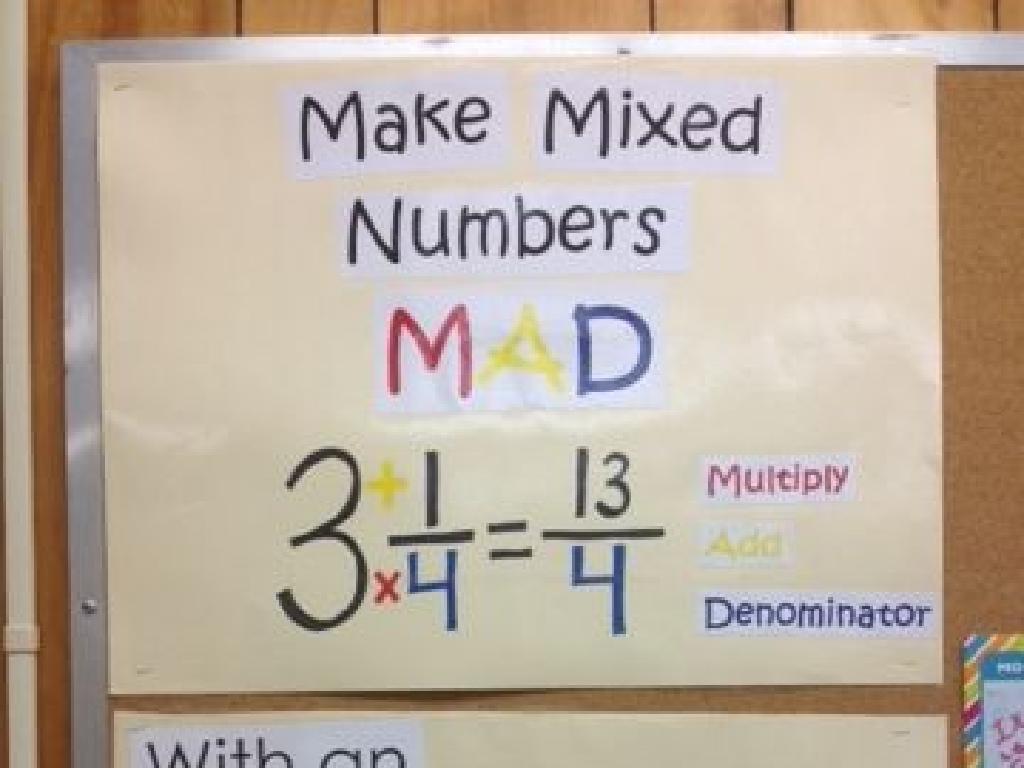Identify Functions Of Plant Cell Parts
Subject: Science
Grade: Fourth grade
Topic: Cells
Please LOG IN to download the presentation. Access is available to registered users only.
View More Content
Exploring Plant Cells
– Plant cells as building blocks
– Just like bricks build houses, plant cells build plants.
– Unique features of plant cells
– Plant cells have cell walls and chloroplasts, unlike animal cells.
– Functions of cell parts
– Each part of a cell has a special job, like making food or protecting the cell.
– Importance of plant cells
– Plant cells work together to make food, grow, and keep the plant healthy.
|
This slide introduces students to the concept of plant cells as the fundamental building blocks of all plant life. Emphasize the unique aspects of plant cells, such as the presence of a cell wall and chloroplasts, which differentiate them from animal cells. Discuss the various functions of plant cell parts, such as the chloroplasts’ role in photosynthesis and the cell wall’s function in providing structure and protection. Highlight the importance of each part working together to ensure the plant’s growth, health, and ability to produce food through photosynthesis. Encourage students to think about how each cell part contributes to the plant’s overall function and survival.
Exploring Plant Cells: The Building Blocks of Life
– Cells: Basic units of life
– Like bricks in a building, cells make up all life.
– All living things are cell-made
– Trees, flowers, and even you are made of cells!
– Plant vs. Animal Cells
– Plant cells have cell walls, but animal cells do not.
– Unique parts of plant cells
– Chloroplasts in plant cells make food using sunlight.
|
This slide introduces the concept of cells as the fundamental unit of life, emphasizing their role as the building blocks of all living organisms. Highlight the differences between plant and animal cells, such as the presence of a cell wall and chloroplasts in plant cells, which are absent in animal cells. These unique features allow plants to create their own food through photosynthesis. Encourage students to think about the variety of living things they know and understand that they all are composed of cells. Use diagrams to visually represent the differences between plant and animal cells. This will set the foundation for further discussion on the specific functions of plant cell parts.
Exploring Plant Cell Parts
– Discover cell wall, membrane, and more
– Learn about the different parts like the sturdy cell wall and the selective cell membrane.
– Cell wall: A plant cell’s shield
– The cell wall is strong and protects the cell, keeping it in shape.
– Chloroplasts: Where food is made
– Chloroplasts contain chlorophyll, helping plants make food through photosynthesis.
– Nucleus: The control center
– The nucleus contains DNA and directs all cell activities.
|
This slide introduces students to the various parts of a plant cell and their functions. Start by discussing the cell wall and cell membrane, emphasizing the protective role of the cell wall and the selective permeability of the membrane. Then, explain the function of chloroplasts in photosynthesis, highlighting how chlorophyll captures sunlight to create food for the plant. Lastly, touch on the nucleus as the command center of the cell. Use diagrams to illustrate each part and provide examples like comparing the cell wall to a suit of armor for protection. Encourage students to think of the cell as a tiny factory, with each part playing a specific role in keeping the plant alive and healthy.
Exploring Plant Cell Parts and Their Functions
– Cell Wall: Provides support
– Like a strong wall around a castle, it protects the cell and maintains its shape.
– Chloroplasts: Enable photosynthesis
– These green structures capture sunlight to make food for the plant.
– Nucleus: Acts as control center
– Just like a principal’s office, it directs all activities within the cell.
– Vacuoles: Store nutrients and waste
– They are like storage rooms, keeping everything tidy and in place.
|
This slide introduces students to the basic functions of plant cell parts. The cell wall is compared to a protective wall, emphasizing its role in support and protection. Chloroplasts are highlighted as the site of photosynthesis, likened to solar powerhouses. The nucleus is described as the control center, akin to a principal’s office, overseeing the cell’s operations. Lastly, vacuoles are mentioned for their role in storage. Encourage students to think of the cell as a tiny city, with each part performing a specific job to keep the city running smoothly. This analogy helps them understand the complex interplay of cell parts in a relatable way.
Photosynthesis: A Closer Look
– Chloroplasts: Sunlight to Energy
– Chloroplasts in plant cells capture sunlight and start photosynthesis.
– Photosynthesis Recipe: Ingredients
– Sunlight, water, and CO2 are combined to make glucose, a type of sugar.
– Oxygen: Essential for Breathing
– Plants release oxygen as a byproduct, which we need to breathe.
– Photosynthesis: Plant’s Food Making
– Plants use glucose as food for energy and growth.
|
This slide introduces the process of photosynthesis, where chloroplasts in plant cells convert sunlight into energy. It’s important to explain that chloroplasts are like tiny factories using sunlight, water, and carbon dioxide to produce glucose, which is the food for the plant. Oxygen, which is vital for human and animal life, is released during this process. Emphasize the significance of photosynthesis in the cycle of life, and how it connects plants and animals. Encourage students to think about how plants are the base of the food chain and the role of sunlight in the energy cycle of our planet.
Exploring More Cell Parts
– Mitochondria: Powerhouse of cells
– They break down nutrients to create energy.
– Vacuoles: Storage sacs for cells
– Vacuoles store water, food, or waste.
– Discovering other organelles
– Like lysosomes, chloroplasts, and the Golgi body.
– Each part has a unique function
|
This slide aims to introduce students to the various components of plant cells beyond the nucleus. Mitochondria are explained as the site of energy production, converting nutrients into energy that the cell can use. Vacuoles are presented as storage centers, holding materials like water, nutrients, and waste. Other organelles, such as lysosomes, chloroplasts, and the Golgi apparatus, are mentioned to pique interest in their diverse functions. Emphasize that each organelle plays a specific role, contributing to the overall health and function of the cell. Encourage students to think of the cell as a factory with different departments, each with its own job to keep the factory running smoothly.
Let’s Review Plant Cell Functions!
– Play a matching game with cell parts
– Take a quick quiz on plant cell parts
– Discuss the importance of plant cells
– How do plant cells help plants grow and why is that important for us?
– Understand how cells contribute to plant life
– Each part of a plant cell has a unique function that helps the plant to live and grow.
|
This slide is designed to reinforce the students’ understanding of plant cell parts and their functions through interactive activities. Begin with a matching game where students pair cell parts with their functions, which will help solidify their memory of the material. Follow up with a quick quiz to assess their knowledge retention. Engage the class in a discussion about the importance of plant cells, emphasizing how they contribute to the growth of plants, which in turn provide us with oxygen, food, and other resources. Encourage students to think about how plant cells work together to create a living organism. This will help them appreciate the complexity and importance of plant life.
Class Activity: Build a Plant Cell Model
– Create your own plant cell model
– Gather clay, cardboard, and paint
– Assemble the cell parts using materials
Use clay for organelles, cardboard as the base, and paint to color code
– Present and explain your model
Describe each cell part and its function
|
This hands-on activity is designed to help students identify and understand the functions of plant cell parts by creating a 3D model. Provide students with clay, cardboard, and paint to construct their models. Each student will mold organelles from clay, attach them to a cardboard base, and use paint to differentiate the parts. Encourage creativity while ensuring they represent the cell accurately. After building, students will present their models to the class, explaining the function of each part, such as the nucleus, cell wall, and chloroplasts. This activity will reinforce their knowledge through visual and tactile learning. Possible variations include using different materials for organelles or working in groups to build larger models.




/postwar_america_transformation.jpg)
